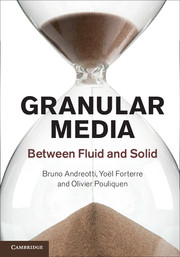3654 results in ebooks in fluid mechanics
9 - Geomorphology
-
- Book:
- Granular Media
- Published online:
- 05 June 2013
- Print publication:
- 13 June 2013, pp 363-431
-
- Chapter
- Export citation
Frontmatter
-
- Book:
- Granular Media
- Published online:
- 05 June 2013
- Print publication:
- 13 June 2013, pp i-iv
-
- Chapter
- Export citation
2 - Interactions at the grain level
-
- Book:
- Granular Media
- Published online:
- 05 June 2013
- Print publication:
- 13 June 2013, pp 15-58
-
- Chapter
- Export citation
Foreword
-
- Book:
- Granular Media
- Published online:
- 05 June 2013
- Print publication:
- 13 June 2013, pp vii-viii
-
- Chapter
- Export citation
References
-
- Book:
- Granular Media
- Published online:
- 05 June 2013
- Print publication:
- 13 June 2013, pp 432-458
-
- Chapter
- Export citation
5 - Granular gases
-
- Book:
- Granular Media
- Published online:
- 05 June 2013
- Print publication:
- 13 June 2013, pp 169-214
-
- Chapter
- Export citation
6 - The granular liquid
-
- Book:
- Granular Media
- Published online:
- 05 June 2013
- Print publication:
- 13 June 2013, pp 215-284
-
- Chapter
- Export citation
8 - Erosion and sediment transport
-
- Book:
- Granular Media
- Published online:
- 05 June 2013
- Print publication:
- 13 June 2013, pp 311-362
-
- Chapter
- Export citation
Index
-
- Book:
- Granular Media
- Published online:
- 05 June 2013
- Print publication:
- 13 June 2013, pp 459-462
-
- Chapter
- Export citation
4 - The granular solid: plasticity
-
- Book:
- Granular Media
- Published online:
- 05 June 2013
- Print publication:
- 13 June 2013, pp 122-168
-
- Chapter
- Export citation
Contents
-
- Book:
- Granular Media
- Published online:
- 05 June 2013
- Print publication:
- 13 June 2013, pp v-vi
-
- Chapter
- Export citation
1 - Introduction
-
- Book:
- Granular Media
- Published online:
- 05 June 2013
- Print publication:
- 13 June 2013, pp 1-14
-
- Chapter
- Export citation

Granular Media
- Between Fluid and Solid
-
- Published online:
- 05 June 2013
- Print publication:
- 13 June 2013
5 - Mesoscale models for physical and chemical processes
-
- Book:
- Computational Models for Polydisperse Particulate and Multiphase Systems
- Published online:
- 05 March 2013
- Print publication:
- 28 March 2013, pp 136-213
-
- Chapter
- Export citation
1 - Introduction
-
- Book:
- Computational Models for Polydisperse Particulate and Multiphase Systems
- Published online:
- 05 March 2013
- Print publication:
- 28 March 2013, pp 1-29
-
- Chapter
- Export citation
2 - Mesoscale description of polydisperse systems
-
- Book:
- Computational Models for Polydisperse Particulate and Multiphase Systems
- Published online:
- 05 March 2013
- Print publication:
- 28 March 2013, pp 30-46
-
- Chapter
- Export citation
Appendix A - Moment-inversion algorithms
-
- Book:
- Computational Models for Polydisperse Particulate and Multiphase Systems
- Published online:
- 05 March 2013
- Print publication:
- 28 March 2013, pp 403-420
-
- Chapter
- Export citation
8 - Moment methods for inhomogeneous systems
-
- Book:
- Computational Models for Polydisperse Particulate and Multiphase Systems
- Published online:
- 05 March 2013
- Print publication:
- 28 March 2013, pp 329-402
-
- Chapter
- Export citation
3 - Quadrature-based moment methods
-
- Book:
- Computational Models for Polydisperse Particulate and Multiphase Systems
- Published online:
- 05 March 2013
- Print publication:
- 28 March 2013, pp 47-101
-
- Chapter
- Export citation
Contents
-
- Book:
- Computational Models for Polydisperse Particulate and Multiphase Systems
- Published online:
- 05 March 2013
- Print publication:
- 28 March 2013, pp vii-xii
-
- Chapter
- Export citation
